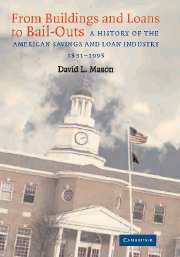 From Buildings and Loans to Bail-Outs
From Buildings and Loans to Bail-Outs Book contents
- Frontmatter
- Contents
- List of Tables
- Acknowledgments
- Introduction
- 1 A Movement Takes Shape, 1831–1899
- 2 The Rise of the League, 1900–1929
- 3 From State to Federal Oversight
- 4 The Movement Becomes an Industry, 1930–1945
- 5 The Glory Years, 1946–1955
- 6 External Challenges and Internal Divisions, 1956–1966
- 7 Lost Opportunities, 1967–1979
- 8 Deregulation and Disaster, 1979–1988
- 9 Resolving the Crisis, Restoring the Confidence, 1989–1995
- 10 The American Savings and Loan Industry in Perspective
- Appendices
- Bibliography
- Index
8 - Deregulation and Disaster, 1979–1988
Published online by Cambridge University Press: 29 October 2009
- Frontmatter
- Contents
- List of Tables
- Acknowledgments
- Introduction
- 1 A Movement Takes Shape, 1831–1899
- 2 The Rise of the League, 1900–1929
- 3 From State to Federal Oversight
- 4 The Movement Becomes an Industry, 1930–1945
- 5 The Glory Years, 1946–1955
- 6 External Challenges and Internal Divisions, 1956–1966
- 7 Lost Opportunities, 1967–1979
- 8 Deregulation and Disaster, 1979–1988
- 9 Resolving the Crisis, Restoring the Confidence, 1989–1995
- 10 The American Savings and Loan Industry in Perspective
- Appendices
- Bibliography
- Index
Summary
The 1980s was the most difficult and trying decade for savings and loans since the 1930s. It began poorly when interest rates soared and the American economy slid into the deepest recession since the end of World War II. Such unprecedented economic conditions hurt all financial institutions, with the thrift industry experiencing record losses and even failures. The severity of these problems led Congress to pass the first significant financial reform legislation in nearly fifty years. In 1980, the Depository Institutions Deregulation and Monetary Control Act initiated deregulation by relaxing controls on interest rates and depository services, while the Garn-St. Germain Depository Institutions Act of 1982 completed the process by expanding thrift lending powers. The return of economic growth in 1983 helped the industry rebound as hundreds of S&Ls took advantage of the new business opportunities afforded by deregulation. Unfortunately, not all thrifts made the transition smoothly. The number of insolvent associations rose in the mid-1980s, and in 1985 there were even deposit runs reminiscent of the Great Depression. When federal regulators tried to impose greater discipline on the industry, efforts by the League, key legislators, and White House officials to downplay the severity of the crisis prevented any substantive changes. The bankruptcy of the Federal Savings and Loan Insurance Corp. (FSLIC) in 1987 finally forced Congress to act, but its responses proved inadequate and the number of insolvent thrifts (some of which involved fraud) grew larger.
- Type
- Chapter
- Information
- From Buildings and Loans to Bail-OutsA History of the American Savings and Loan Industry, 1831–1995, pp. 213 - 240Publisher: Cambridge University PressPrint publication year: 2004
